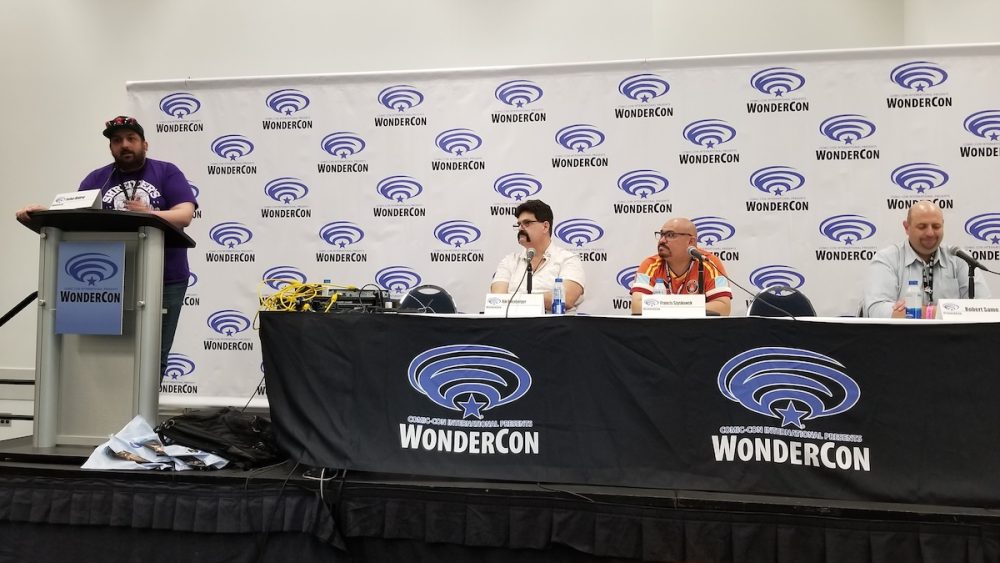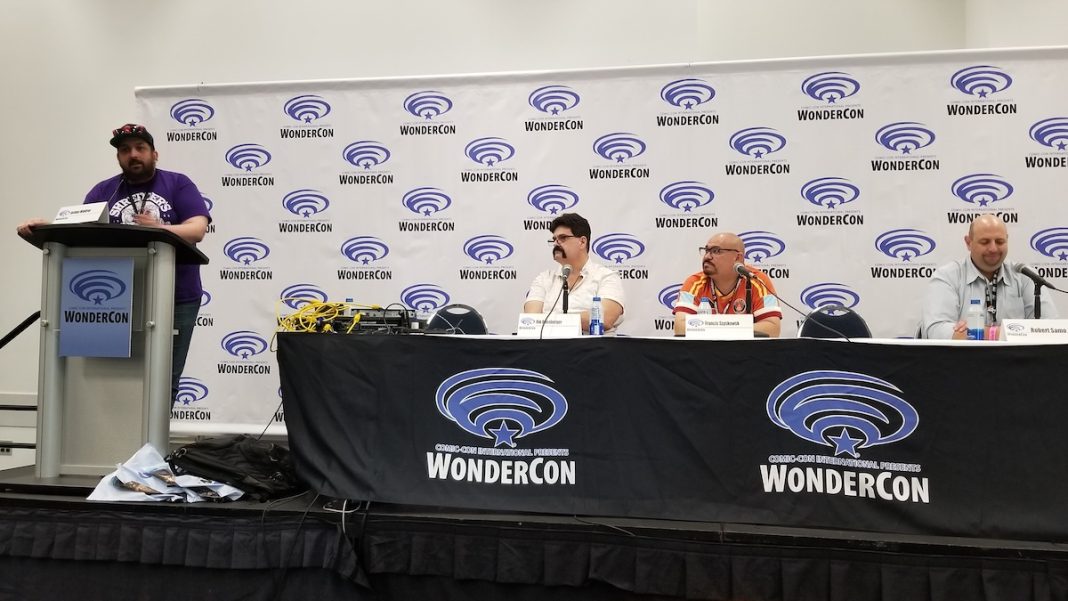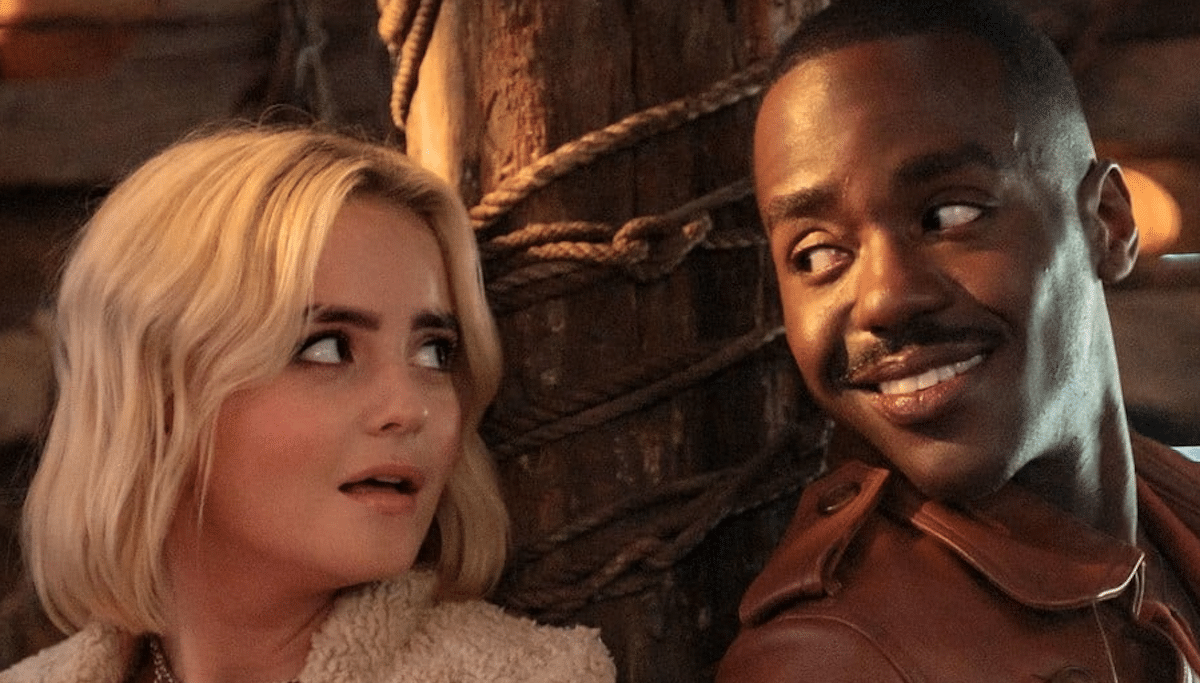By Gabriel Neeb
Wrestling and comics have nothing in common. One has overly dramatic stories involving characters wearing weird costumes with bizarre names and the other- oh. Okay, there are a few similarities. At Wondercon 2022, as part of an informal series on comics and wrestling which has been going on for 15 years across the San Diego, Long Beach and Anaheim conventions, four gentlemen that have worked in both comics and professional wrestling gathered in Room 211 at the Anaheim Convention Center to discuss the similarities comics and wrestling share in “Not So Strange Bedfellows: The Relationship Between Comics and Professional Wrestling.”
Moderated by Joshua Waldrop (Ultima Comics), Rik Offenberger (First Comics News), Francis Srykowski (The Massacre Twins), and Robert Samo gathered to discuss the matter extensively.

Offenberger kicked things off by telling the audience about his new Kickstarter campaign for G-MAN comics which had just sold out its “Create Your Own Character” category.
Robert countered by expressing delight that his name plate spelled his name correctly- something his own high school yearbook failed to do.
From there, we were told to “cut the shine” and proceed with the panel topics like applying story to comics and wrestling.
One of the greatest similarities was that in book comics and wrestling, is the importance of telling the story immediately. Both present several stories at the same time. For instance, a panel alone is its own story, which leads to the bigger story of the page… which is then a lead into the bigger stories of the issue and further issues.
Wrestling is similar in that the match, almost always featuring two characters, is part of a larger story with its own psychology and motivations. Monday Night RAW, World Wrestling Entertainment’s (WWE) flagship show, is its own story designed to present a story and get the viewer to return for the next episode… which builds up to Wrestlemania (Wrestlemania 38 happening this weekend).
The discussion soon moved onto characters and crafting them in the story. Readers and viewers respond to the high spots of a story, but the panel agreed that the journey to those high points had to be built up. New characters need the build-up to come even quicker… or the audience isn’t coming back.
New characters can often hang on… until the next “new” comes along with only a few characters breaking out of this (like Venom or Deadpool in comics or Roman Reigns in wrestling, among others).
The main idea being that stories are like a ride, specifically a rollercoaster: the story builds up to the highs where a ride of all highs is either sickening or boring.
All action and no development is boring.
Then there are the roots of motivations as all interesting characters have some tendency of the “heel” inside them. In comics, the best villains often think they’re the good guy. The best of this being that of Dr. Doom who is often written as thinking he protects his home of Latveria against the outside world (with Robert thinking that MJF of All Elite Wrestling [AEW] being wrestling’s answer to Dr. Doom).
The development of the story continued, specifically with the example of super kicks in matches. 43 super kicks can be too much in a match, but if there were 42, and the 43rd hit! That kick means something.
Of course, there are some things, phenomena, that comics and wrestling share which don’t translate to other media. The absurdity being key. The Road Warriors tag team, with the spiked costumes, being one, or the time where the Four Horsemen chased down Dusty Rhodes- complete with camera crew- and broke his hand.
None of this being able to work in the real world.
Underlying all of this being the need for a compelling story… or strange things happen. Like Mae Young giving birth to a hand. Yes, non-wrestling fans, that happened.
Reinventions of wrestling characters happen, Hulk Hogan and Chris Jericho being more notable ones.
The conversation then moved over to the debut of the internet- something that happened in the professional lives of all the panelists. The effects have been varied, with the biggest being that some of the stories which used to being short, have expanded. Some tales that required one issue (or show) now take more than a year, or several Wrestlemanias.
Also, from the viewpoint of the observers, the need to “break” a story tends to override the suspense or, “the rabbit in the hat.” For wrestling, the “kayfabe” where the need to keep the secret, secret, suffers against the impulse to know everything.
One thing the panel agreed on, was that there were so many nuances to telling a story, that they need to be learned through experience.
Miss any of our previous WonderCon 2022 coverage? Click here!







